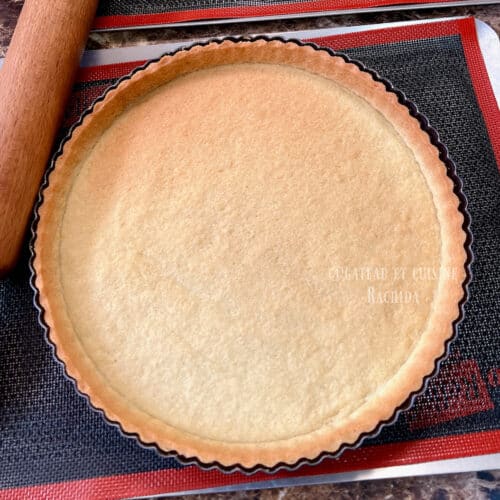
Sweet Shortcrust Pastry Recipe (pâte sablée)
An easy, foolproof shortcrust, perfect pie crust (French pâte sablée) that takes less than 10 minutes to prepare, resulting in a perfect tart base that won’t shrink or puff up during baking.
SERVING:2 pie shells
PRINT
PIN
SAVE
EQUIPEMENTS
INGREDIENTS
For 2 tart shells, 22 cm each (8.7 inches) :
- 250 g all-purpose flour (8.8 oz)
- 130 g cold but not hard butter, cut into small pieces (4.6 oz )
- 100 g powdered sugar (3.5 oz)
- 30 g almond flour (optional) (1 oz )
- 1 large egg (60 g / 2 oz), adjusted according to flour absorption
- 1/3 teaspoon salt (1 g / 0.04 oz)
- 1 vanilla bean optional
PREPARATION
- In the bowl of a stand mixer or in a large mixing bowl, sift the flour and powdered sugar.
- Add the salt, almond powder and seeds from the split vanilla pod. Mix well.
- Add the cold but not hard butter and work it with the stand mixer fitted with the paddle attachment (K) or with your fingertips to rub in the butter until you achieve a crumbly texture. The butter should no longer be visible.
- Add the lightly beaten egg and mix briefly to combine everything until the dough begins to come together. Stop the mixer midway to scrape down the sides of the bowl. Don't stir until the mixture forms a ball.
- If the dough is dry, add a little more egg. The dough should be soft and easily shape into a ball. Even if it is sticky, it will firm up in the refrigerator.
- Turn the dough out onto the work surface, then press and push it in front of you with the palm of your hand, 2 to 3 times. This ensures that the butter is well incorporated and the texture is homogenous.
- Gather the dough into a ball using a bench scraper. Flatten slightly to form a disk. This will speed up its cooling and make it easier to roll out.
- Wrap in cling film and leave in the fridge for at least 2 hours (ideally overnight to relax).
- Before rolling out, take the dough out of the fridge and leave to rest for 5-10 minutes to soften slightly.
- Roll out the dough on a lightly floured surface to a thickness of 2 to 3 mm. In warm weather, roll it out between two Silpat baking mats or two sheets of parchment paper. Firm it up a bit in the refrigerator if it becomes sticky.
- Gently place the rolled-out dough into the buttered tart pan. Gently press the dough into the bottom and sides of the pan. Make sure to press the dough firmly against the sides of the pan, forming a right angle between the bottom and the sides. This helps prevent the dough from shrinking during baking.
- To smooth the bottom and sides without leaving fingerprints, place a piece of parchment paper over the dough. Use your fingers to press down over the paper to evenly flatten the dough and achieve a smooth surface. Refine the dough by pushing any excess up towards the top, which helps to even out the thickness along the entire height of the sides of the pan.
- Trim the excess dough by rolling a rolling pin over the edge of the pan, then use a knife to even out and create clean edges.
- For blind baking, place the tart mold in the freezer for 30 minutes to 1 hour before baking. You can bake it without using weights or pricking it with a fork.
- Note: Use a perforated tart ring and a perforated baking sheet or a Silpain baking mat for optimal results.
- Preheat the oven to 160°C (320°F) fan-assisted or 170°C (340°F) static.
- Bake for about 15 minutes for blind baking. It should be lightly golden.
- Let the tart shell cool before filling, then bake again to finish the cooking.
- You can also bake all the way through. Bake until the tart shell is golden brown. The blind-baked tart shell will be used for fillings that do not require further baking, such as chocolate tart, lemon tart, etc.
- Pre-baking the tart shell
- Note: If you want to line the tart mold in two steps, with a disc for the bottom and strips for the sides, you can see the method in my article on sweet pastry or how to line tart rings like a pro. This method is more practical in the summer when the dough becomes sticky quickly.